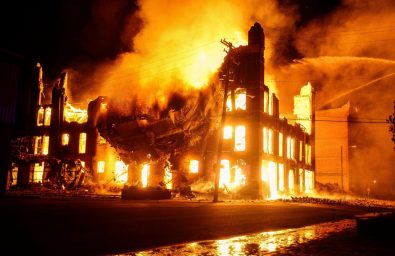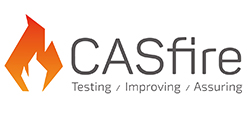
According to statistics, building fires are the most common and dangerous fire accidents in the world. Fires which endanger human life and property most often occur in buildings.
At the same time, fire also brings different degrees of damage to the environment and ecosystem, and also brings unstable factors to society.
Fire Testing to
Building Material
European Standards:
- EN 13501-1:2007:Fire classification of construction products and building elements-Part1: Classification using data from reaction to fire tests
| Non-Flooring
A1,A2, B,C,D,E,F |
Class A1: EN ISO 1182 and EN ISO 1716 |
| Class A2: EN 13823 SBI test and ISO 1182 or ISO 1716 | |
| Class B,C or D: EN ISO 11925-2 and EN 13823 SBI | |
| Class E: EN ISO 11925-2 | |
| Class F: Not Reach Class E | |
| Flooring
A1fl ,A2fl ,Bfl,Cfl, Dfl,Efl,Ffl |
Class A1fl: EN ISO 1182 and EN ISO 1716 |
| Class A2fl: ISO 9239-1 and ISO 1182 or ISO 1176 | |
| Class Bfl,Cfl,Dfl:
EN ISO 11925-2 and ISO 9239-1 |
|
| Class Efl: EN ISO 11925-2 | |
| Class Ffl: Not reach class Efl |
- EN13823 Reaction to fire tests for building products ― Building products excluding floorings exposed to the thermal attack by a single burning item
- ENV 1187 Fire tests on building materials and structures — Test methods for external fire exposure to roofs
Chinese Standards:
- GB 8624-2012: Classification for burning behavior of building materials
GB 8624 to non-flooring products
| Class | Test Method | |
| Class A | A1 | GB/T 5464 and GB/T 14402 |
| A2 | GB/T 20284 and GB/T 5464 or GB/T 14402 | |
| Class B1 | B | GB/T 8626 and GB/T 20284 |
| C | GB/T 8626 and GB/T 20284 | |
| Class B2 | D | GB/T 8626 and GB/T 20284 |
| E | GB/T 8626 | |
| Class B3 | F | not reach Class E |
GB 8624 to flooring products
| Class | Test Method | |
| Class A | A1 | GB/T 5464 and GB/T 14402 |
| A2 | GB/T 11785 and
GB/T 5464 or GB/T 14402 |
|
| Class B1 | B | GB/T 8626 and GB/T 11785 |
| C | GB/T 8626 and GB/T 11785 | |
| Class B2 | D | GB/T 8626 and GB/T11785 |
| E | GB/T 8626 | |
| Class B3 | F | Not Reach Class E |
GB8624 to curtain, textile for furniture:
| Class | Test Method |
| Class B1 | GB/T 5454 Oxygen Index &GB/T 5455 Vertical burning |
| Class B2 | GB/T 5454 Oxygen Index &GB/T 5455 Vertical burning |
| Class B3 | No Requirement |
GB 8624 to Furniture:
| Class | Products | Test Methods |
| Class B1 | Upholstered Furniture | GB/T 27904 ,GB/T17927.1 |
| Hard Furniture | GB/T 27904 | |
| Class B2 | Upholstered Furniture | GB/T 27904, GB/T17927.1 |
| Hard Furniture | GB/T 27904 | |
| Class B3 | No Requirement | |
- GB/T 20284 Single burning item test for building materials and products
- GB/T 14402 Reaction to fire test for building materials and products-Determination of the heat of combustion
- GB/T 8626:Test method of flammability for building materials
- GB/T 11785:Reaction to fire tests for floorings-Determination of the burning behaviour using a radiant heat source
- GB/T 5464:Non-combustibility test method of building materials
- GB/T 5454:Textiles-Burning behaviour-Oxygen index method
- GB/T 8627: Test methods for Smoke Density of Building material
GB/T 2408:Plastics-Determination of burning characteristics-Horizontal and vertical test
- GB/T2406.1 Plastics-Determination of buring behaviour by oxygen index-Part 1:Guidance.
- GB20286 Requirements and mark on burning behavior of fire retarding products and subassemblies in public place
- GB/T 16172:Test method of Heat release rate of building materials
- GB/T 8924:Fiber Reinforced Plastics-Burning behaviour-Oxygen index method
- GB 15763.1:Safety glazing materials in building-part 1: Fire-resistant glass.
- GB12441 General technical specifications for finishing fire retardant paint
British Standards:
- BS 476-3 Fire tests on building materials and structures — Part 3: Classification and method of test for external fire exposure to roofs
- BS 476-4 Fire tests on building materials and structures- Part 4: Non-combustibility test for materials
- BS476-5 Fire tests in building materials and structures Part 5: method of test for ignitability
- BS 476-6 Fire Tests on Building materials and structures – Method of test for fire propagation for products
- BS 476-7 Fire Tests on Building materials and structures – Method of test to determine the classification of the surface spread of flame of products
- BS 476-11 Fire tests on building materials and structures — Part 11: Method for assessing the heat emission from building materials
- BS 476-12 Fire tests on building materials and structures-Part 12: Method of test for ignitability of products by direct flame impingement.
- BS 476-15 Fire Tests on Building Materials and Structures Part 15: Method of Measuring the Rate of Heat Release of Products
- BS 7955 Containment nets and sheets on construction works – Specification for performance and test methods
- BS 5839-1:Fire detection and fire alarm systems for buildings — Part 1: Code of practice for system design, installation, commissioning and maintenance
- BS 5803-3:Thermal insulation for use in pitched roof spaces in dwellings. Specification for cellulose fibre thermal insulation for application by blowing.
- BS 5803-2:Thermal insulation for use in pitched roof spaces in dwellings- Part 2: Specification for man-made mineral fibre thermal insulation in pelleted or granular form for application by blowing.
Australian Standards:
- AS/NZS 1530.1:Methods for fire tests on building materials,components and structures – Combustibility test for materials
- AS/NZS 1530.2:Methods for fire tests on building materials,Components and structures – Test for flammability of materials
- AS/NZS 1530.3:Methods for fire tests on Building Materials,Components and Structures – Part 3: Simultaneous Determination of Ignitability,Flame Propagation. Heat Release and Smoke Release
- AS/NZS 3837:Method of test for heat and smoke release rates for materials and products using an oxygen consumption calorimeter
American Standards:
- ASTM E 84 Standard Test Method for Surface Burning Characteristics of Building Materials
- ASTM E136 Non-combustibility test
- ASTM E 162: Standard test method for surface flammability of materials using a radiant heat energy source.
- ASTM E648:Standard Test Method for Critical Radiant Flux of Floor-Covering Systems Using a Radiant Heat
- ASTM E1354 Method of test for heat and smoke release rates for materials and products using an Oxygen Consumption Calorimeter
- ASTM D3675: Standard test method for surface flammability of flexible cellular materials using radiant heat energy source.
- ASTM D2843 Standard Test Method for Density of Smoke from the Burning or Decomposition of plastics
- ASTM E 970:Standard Test Method for Critical Radiant Flux of Exposed Attic Floor Insulation Using a Radiant Heat Energy Source
- UL 723 Standard Test Method for Surface Burning Characteristics of Building Materials
Germany Standards:
- DIN 4102-1 Fire behaviour of building materials and elements Part 1: Classification of building materials Requirements and testing
Class:A1,A2,B1,B2,B3
French Standards:
- NF P92-507: Building- Construction and furnishing materials- Classification according to reaction to fire
- NF P92-501: Safety against fire: Building materials – Reaction to fire tests. used for rigid material or flexible materials thicker than 5mm
- NF P92-503: Safety against fire: Building materials – Reaction to fire tests. Electrical burner test used for flexible materials
- NF P 92-504: speed of spread of flame test used for the materials which are not intended to be glued on a rigid substrate.
- NF P 92-505: Dripping test with electrical radiator, used for melting materials.
ISO Standards:
- ISO 1716 Reaction to fire tests for building Products- Determination of the heat of combustion
- ISO 1182 Reaction to fire tests for products — Non-combustibility test
- ISO5658-2 Reaction to fire tests-spread of flame-Part 2: Lateral spread on building products in vertical configuration
- ISO5660-1 Reaction to fire tests-Heat release, smoke production and mass loss rate-Part 1: Heat release rate (cone calorimeter method)
- ISO 5660-2: Reaction to fire tests — Heat release, smoke production and mass loss rate — Part 2: Smoke production rate (dynamic measurement)
- ISO 5659-2: Plastics — Smoke generation — Part 2: Determination of optical density by a single-chamber test
- ISO11925-2:Reaction to fire tests-Ignitability of building products subjected to direct impingement of flame-Single-flame source
Canadian Standards:
- CAN/ULC-S102-10:Standard method of test for surface building characteristics of building material and assemblies
- CAN/ULC-S102-3:Standard method of fire test of light diffusers and lenses.
- CAN-ULC-S102-2:Standard method of test for surface building characteristics of flooring, floor coverings, and miscellaneous materials and assemblies.
- CAN/ULC-S135:standard test method for the determination of combustibility parametres of building materials using an oxygen consumption calorimeter.
- CAN/ULC-S127:standard corner wall method of test for flammability characteristics of Non-melting foam plastic building materials.
- CAN/ULC-S114-05:Standard method of test for determination of Non-combustibility in building materials
- CAN/ULC-S129:standard method of test for smoulder resistance of insulation(basket method)
